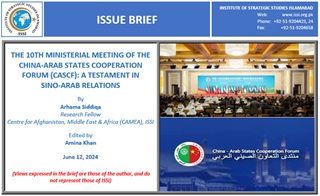In the past decade, China has significantly expanded its diplomatic and commercial footprint in the Middle East. Chinese investment in the Middle East mostly concentrates in the sectors of energy, infrastructure and agriculture. There is also a mutual interest in incorporating China’s multi-billion dollar project, the Belt and Road Initiative (BRI) into national revitalization initiatives such as Saudi Vision 2030, and Kuwait’s Vision 2035.[1] The Middle East’s strategic location at the intersection of Asia, Africa, and Europe as well as waters of the Mediterranean, Red, Arabian, Caspian, and Black—makes it crucial for implementation of the BRI. Furthermore, the area is bordered by the vital sea lanes of the Dardanelles, Bab El-Mandeb Strait, Bosphorus, and Strait of Hormuz.[2]
The year 2024 marks the 20th anniversary of the creation of the China-Arab States Cooperation Forum (CASCF). The 10th ministerial meeting of the CASCF took place in Beijing on May 30, 2024 and concluded with the ratification of the ‘Beijing Declaration’ and the ‘Action Implementation Plan’. The ‘Action Implementation Plan’ will run through 2024-2026. The meeting was attended by leaders from China, Bahrain, Egypt, Tunisia and the United Arab Emirates, the Secretary-General of the League of Arab States Ahmed Aboul-Gheit, and other senior officials from Arab states. During the CASCF, China also ratified a number of bilateral and multilateral cooperation arrangements with participating countries as well as the Arab League’s General Secretariat.[3]















